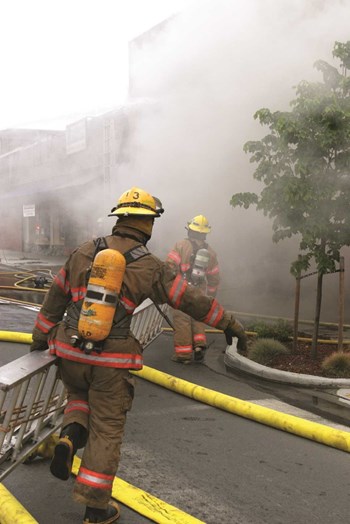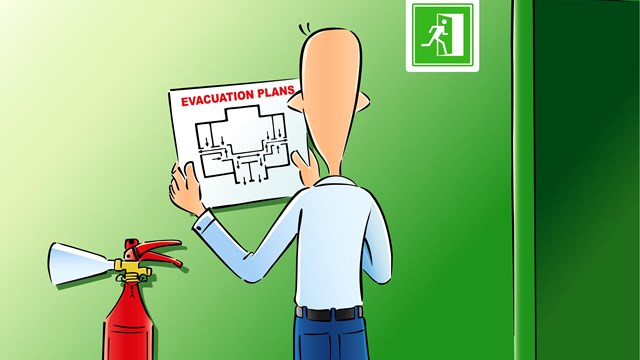
As the devastation of Superstorm Sandy continues to be tallied, (up to nearly $50 billion in the Garden State alone) and New Jersey residents— those who bore the brunt of the disaster, as well as those less directly affected— take stock of the catastrophe, one thing is certain: as part of the ongoing recovery effort, it's crucial for every condo, co-op and HOA to have a solid emergency preparation plan in place in the not-unlikely event of more severe weather occurrences.
While the basics of preventing—and surviving—relatively common events like fires or heavy snowstorms should be well known to anybody living in a community association or planned development, the reality is that each building community is equipped with different equipment, constructed with different materials, and served by unique evacuation routes for emergencies. There's no one-size-fits-all plan that works for every building or association—and as Sandy showed us this past October, there's ample evidence that devastating weather events are no longer once-in-a-century threats. So it’s important for board members and management to devise customized emergency plans for their particular community. That way if the unthinkable happens, everyone can escape quickly and safely.
Have a Plan
The Garden State routinely experiences severe winter weather events to torrential flooding in the fall and in the spring. So the experts say it’s imperative to have a plan. Experts believe that the main areas to focus on are response, recovery and restoration and that the management company and board of directors should work together to prepare a disaster management plan for their community.
A condo association's management could be held liable if there's no plan in place and tragedy results during an emergency. In short, say the pros, preparedness is not an option; it's part of a board/management team’s fiduciary responsibility. In a large condo or co-op, the association’s responsibility includes all the common areas and amenities, plus the physical-plant equipment such as HVAC systems, emergency generators, elevators, fire alarm systems, emergency lighting, and other life-safety systems that require additional protection and maintenance.
Resources Abound
While crises such as power outages or damage from high winds or heavy snow and ice are practically routine for New Jersey HOAs, staff and residents alike should be ready for any eventuality—and the elements of readiness are the same for any emergency. Boards and managers can create and implement customized emergency plans for their buildings, but they must know where to look to find the right information and with whom to work to make the plan.
Governmental agencies are a great place to go for pre-planning tips and information, and emergency response professionals will come to your building or HOA to educate, advise and prepare long before you need to execute an evacuation. The American Red Cross has long been known for helping those affected by disasters, but the group also works to educate people how to be ready for them before they happen. The group advises unit owners to have an emergency kit or “go bag” containing prescriptions, some food and water, money, clothes and a few other necessities ready to roll in case of a crisis, and also makes simple emergency-planning advice is available online from the American Red Cross at www.redcross.org and www.myred cross.org. The Federal Emergency Management Agency (FEMA) is another such resource, and can be found online at www.ready.gov and www.fema.gov/are-you-ready-guide.
Under the direction of Colonel Rick Fuentes, the New Jersey Office of Emergency Management (NJOEM) works with local, regional, state, and federal partners in case of emergencies. “It’s all about partnerships,” says Lieutenant Stephen Jones, director of communications for the New Jersey State Police Department in Trenton. “We are a resource coordinator. We move resources from the federal level down through the counties and the counties coordinate with their locals. We also help guide resources between counties. For example, for Hurricane Sandy counties on the west side of the state wasn’t really hit that bad, so we moved some of their resources to help counties out on the East Coast that was hit badly.”
The NJOEM website is a rich resource for boards, managers, and residents alike—along with local police and fire departments. For information on how to plan and prepare for emergencies in the Garden State go to www.ready.nj.gov.
“We are one of the rare states that the Office of Emergency Management falls under the state police,” adds Jones. “For most states it’s a separate office but for New Jersey, the troopers man all the key positions and the superintendent of the state police serves a dual role as director of the Office of Emergency Management.”
Regardless of a building’s evacuation plan, residents also may need to make their own contingency plans based on their family's specific needs. For example, what if a disaster happens during the day, when mom is at home, and dad’s at work and the kids are at school? Each member of the family should know where they will meet if the building is evacuated or they are separated due to an emergency. Residents also need to recognize the necessity of having a plan in place for their pets.
Putting Plans Into Action
When a condo building or homeowners association calls upon the Red Cross to come assess and fortify their emergency planning protocols, a representative from the organization will meet with residents and community administrators and educate them on how to prepare by having the right supplies, by being ready to enact the community's plan, and by informing themselves before, during, and after the emergency.
“We have corporate preparedness programs and will go in and do a full facility audit,” says Lynn Duddy, a training specialist for the American Red Cross. “We then generate a report that includes recommendations.” The auditing process includes evaluating the association’s emergency action plan, and creating one or selecting a better template for one if the current plan is less than optimal.
According to Duddy, “A full assessment of emergency preparedness plans requires knowing what type of equipment the building has, obtaining evacuation routes, and assessing individual residents’ special needs in an emergency.” It’s about being what the organization calls “Red Cross Ready”—meaning having supplies on hand such as food, water, and medicine for use in an emergency situation. Multifamily buildings and condos should have supplies such as flashlights, extra fuel (if necessary for a generator), and other necessities ready to be mobilized when called upon. A designated person in the building such as a superintendent or other staff member should be responsible for replacing those building supplies and ensuring that they are usable.
Preparedness also amounts to having a plan for residents to shelter in place—i.e., for them to stay put in the building for a while, if needed. A proper shelter in place plan should account for the building community’s needs for at least a period of three days. That means having adequate drinking water, food, batteries, flashlights, first aid supplies and even extra clothing for residents, in case it is needed.
Reducing Risk
For Vernon Rupert Grant, owner of Crisisology Group International, an emergency management and planning company, another start to preparing for an emergency involves reducing the possibility of a crisis. Working to prevent a fire should be the objective of any building manager, and a manager can begin to accomplish this by eliminating building violations such as inoperable emergency exits, maintenance problems that could pose fire hazards, and the like. “The superintendent is the first line of defense in a building emergency,” Grant says, adding that every building should have a mitigation plan, to lessen the possibility of an emergency.
Property managers and superintendents should regularly walk around their buildings and grounds and assess the potential hazards. Such problems as a faulty fire alarm system, inoperable doors, windows that cannot be opened or fully closed, and bad wiring or plumbing that could create a hazard all must be noted when the super and manager investigate the building as part of their mitigation plan. After noting areas in need of attention, either building staff or outside contractors should be brought in to make the necessary repair or correct the unsafe condition.
Expecting Contingencies
As with just about every aspect of day-to-day residential management, communication is key to managing crises and minimizing their impact. Whether you're faced with a fire, a storm with power outages, or flooding, boards and management can begin to plan for emergencies affecting their properties by simply getting the dialogue started.
“The superintendent should begin a dialogue around the neighborhood, and the property manager should be talking with other property managers, people in the neighborhood, and city officials about crisis and emergency planning,” Grant says.
One way to consolidate and standardize an association's emergency response plan is to establish an emergency team, comprised of the co-op board members, the facilities manager, building security personnel, and the building’s engineer, along with some competent, capable resident volunteers. The people in charge of the group, and in charge during an emergency, should be trained in both CPR and first aid. The property manager should be the team leader during a crisis situation.
During an emergency, the management team should know who is in the building and who is not. That understanding will be informed by crucial data the team compiles long before a crisis. Through a survey of the building, the team should know how many people live in the building, which of them have special needs or lack mobility and will need help evacuating, who has small children, who has pets, and who works from home. This evacuation list should include names, phone numbers, and apartment numbers of all residents, and should be backed up remotely, not simply stored on-site. That way, if anything happens to the property manager’s computer in the building, the info can be sent directly to another laptop or device during an emergency.
Specific considerations may need to be made for a building’s “special-needs” residents, such as the elderly, ill or disabled individuals, or households with young children who might not be able to follow the same evacuation/emergency protocols as more able-bodied residents. To help such people, members of the emergency team must be designated to assist these folks in a crisis.
Any residential building also should have rally points to go to in an emergency. Rally points are places away from the apartment building, but close to it, where residents will gather in an emergency to relax, deal with what happened, and plan a course of action. And just as having a small radio in your go bag is important to stay informed, rally points also are places where building management can distribute information to residents.
Living Safer
Experts agree that without a plan, people can panic and makes things worse and in order to prevent that from happening it’s vital that boards, managers and concerned residents be willing to ask tough questions and examine whether or not their community is ready for the worst. If not, then it's time to call in the pros, make a new plan, and get the entire community on board—not only for their physical safety, but for their peace of mind.
Hannah Fons is an associate editor at The New Jersey Cooperator. Staff Writer Christy Smith-Sloman contributed to this article.






Leave a Comment